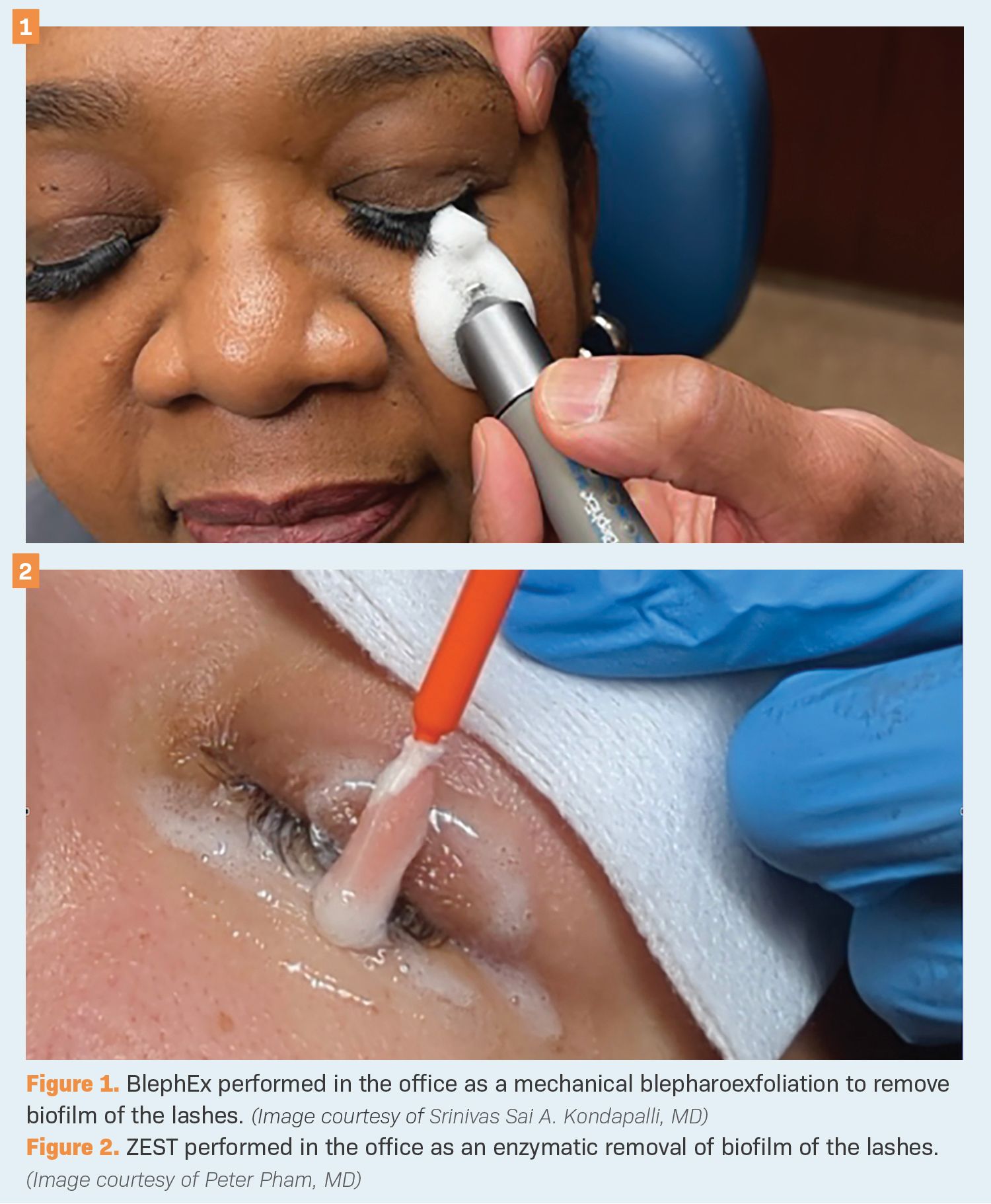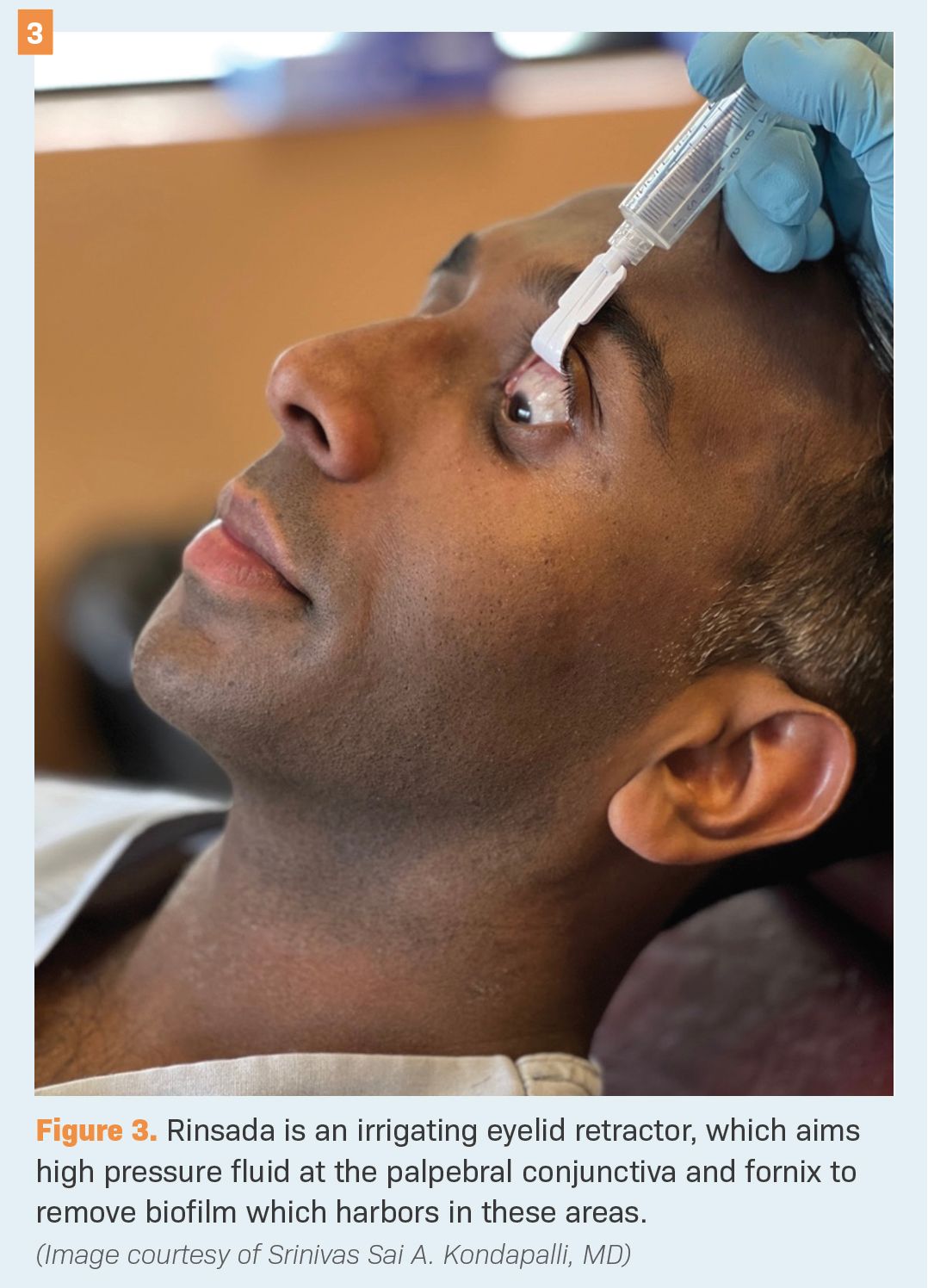- Therapeutic Cataract & Refractive
- Lens Technology
- Glasses
- Ptosis
- AMD
- COVID-19
- DME
- Ocular Surface Disease
- Optic Relief
- Geographic Atrophy
- Cornea
- Conjunctivitis
- LASIK
- Myopia
- Presbyopia
- Allergy
- Nutrition
- Pediatrics
- Retina
- Cataract
- Contact Lenses
- Lid and Lash
- Dry Eye
- Glaucoma
- Refractive Surgery
- Comanagement
- Blepharitis
- OCT
- Patient Care
- Diabetic Eye Disease
- Technology
Biofilm busting 101
An overview of current ocular biofilm removal procedures
Ocular surface biofilms play significant roles in the pathophysiology in ocular surface diseases, including dry eye.1 In general, biofilms describe groups of microorganisms, including bacteria, which produce a matrix that allows for its propagation. Bacterial biofilms have unique structures and microenvironments that evade traditional methods of eradication.2

Ocular biofilms often start at the lid margin and then proceed into the meibomian glands and the palpebral conjunctiva and fornix. Bacteria colonize the lid margin, resulting in blepharitis.3 These bacteria propagate and spread via direct extension or microcolonies seeding into the meibomian glands, palpebral conjunctiva, and conjunctival fornix.3 “The biofilm is an invisible film, a by-product of the lid margin biome, that gradually spreads over time, migrating onto the palpebral conjunctiva and creeping into the fornices. It may cover the orifices of the meibomian glands, leading to decreased meibum secretion onto the tear film, which in turn may lead to exacerbation of evaporative dry eye,” said Cynthia Matossian, MD, FACS, founder of Matossian Eye Associates and past medical director in Doylestown, Pennsylvania.
Methods to remove ocular biofilms vary in mechanism but attempt to improve the ocular surface and improve patient symptoms. The relationship between ocular biofilms and dry eye disease is well established, and in-office procedures target these biofilms at the lid margin, meibomian glands, and palpebral conjunctiva and fornix. Below, we review common biofilm busting procedures.
BlephEx
BlephEx is an in-office procedure performed at the lid margin to improve the signs and symptoms of lid margin blepharitis. The handpiece spins a soft medical- grade sponge along the edge of the eyelids and lashes. The sponge is soaked in an eyelid cleanser, and the eye is anesthetized before the clinician performs the procedure along the eyelid margin. The procedure takes up to 10 minutes.4 “I find it very helpful to reduce the biofilm burden on the lash base both for initial treatment and ongoing maintenance,” said Hall T. McGee, MD, cornea and cataract specialist at Everett and Hurite Eye Care Specialists, Pittsburgh, Pennsylvania (Figure 1)

Zocular Eyelid System Treatment (ZEST)
The ZEST procedure is performed using a kit that contains an okra-based gel that is applied with a microsponge applicator to exfoliate the eyelid margin. The okra-based solution is a polysaccharide, which can be effective in the removal of biofilms enzymatically and is effective against Demodex.5 The kits come as an all-inclusive single-use pack, with no other equipment required. The ZEST procedure is performed in the office and is suggested to be repeated every 6 months (Figure 2).
“The in-office ZEST eyelid hygiene procedure is efficient and highly effective in the gentle removal of Demodex and debridement of accumulated debris of the lid margins,” said Laura M. Periman, MD, founder and director of dry eye services and clinical research at Periman Eye Institute in Seattle, Washington. The advantages include the anti-inflammatory properties of the okra polysaccharides, lack of topical anesthetic requirement, prevention of Demodex and infectious debris microsplatter, and tactile feedback for completion of the biofilm removal. NuLids Designed for home use, NuLids’ handpiece uses a soft tip that mechanically removes the lid margin biofilm. It is designed to be performed by the patient on a daily basis.6 Conversely, NuLids Pro is an in-office device that mechanically removes lid margin biofilm by the physician without the use of anesthetic eye drops. Meibomian gland heating devices. There are a variety of different devices aimed at heating the meibomian glands to facilitate removal of clogged meibum within these glands. Heat facilitates liquefaction of the impacted meibum with or without subsequent mechanical extrusion and expression of the meibomian glands that sit at the lid margin.
» The LipiFlow Thermal Pulsation System uses heat and motion to warm the meibomian glands and is designed to help unclog meibomian glands of the upper and lower lid margins.
» TearCare is a 15-minute heating of the eyelid followed by a manual removal of the meibum. The device heats only the outer eyelid.
» Systane iLux2 is an FDA-approved handheld warming and evacuation device to treat meibomian gland dysfunction. It requires direct physician treatment time during the entire procedure.
Low-level light therapy and intense pulsed light
Low-level light therapy (LLLT) has been used in treatment of a variety of disorders through biomodulation of the cellular metabolism. LLLT has been shown in models to reduce inflammation of the ocular surface and improve blepharitis ntense pulsed light (IPL) uses wavelengths at a range of 500 to 1200 nm. IPL has 5 major mechanisms of action: photocoagulation, photoimmunomodulation, photosanitization, photorejuvenation, and photobiomodulation. IPL is shown to reduce bacterial load on the eyelids.7,8
“In our practice, we bundle IPL, TearCare, and manual expression for recalcitrant dry eye symptoms. We find this bundle of services provides a comprehensive approach to this anterior biofilm,” said Taj Nasser, MD, a refractive, cataract, and anterior segment surgeon at Parkhurst NuVision in San Antonio, Texas.
Rinsada
To date, the biofilm of the palpebral conjunctiva and fornix have been largely ignored in management of ocular surface disease. Rinsada is an irrigating eyelid retractor that targets fluid at the palpebral conjunctiva, conjunctival fornix, and bulbar conjunctiva (Figure 3). The palpebral conjunctiva and fornix house the accessory lacrimal glands, which are the glands of Wolfring and Krause that allow for basal tear secretion. However, biofilm that extends past the lid margin intrudes into the ducts of these exocrine glands.
Using high pressure irrigation, Rinsada mechanically removes biofilm from these anatomic areas. High pressure irrigation of at least 8 psi has been an effective method to remove biofilms.9 Research illustrates a 70% reduction in MMP-9 and, in some patients, this reduction lasted up to 3 months in duration.10, 11
Ada Noh, OD, who is the owner of Noh Eyes, a dry eye specialty clinic in Little Rock, Arkansas, notes, “Rinsada has added another element to treating [patients with] ocular surface disease. [Before] Rinsada, the palpebral conjunctiva and fornix were essentially untreated. Using Rinsada has helped boost patients’ symptomatic relief, and they have come back asking for more.”
Conclusion
Biofilms are being identified with greater clinical significance in multiple human pathologies. In the ocular surface, biofilms play a critical role in dry eye disease, and mechanisms to remove them are evolving to improve patient outcomes and relief. As the bacterial biofilm begins on the epidermis and lashes, it proceeds to invade the meibomian glands of the lid margin. The biofilms continue to invade the palpebral conjunctiva and fornix and into the lumens of the accessory lacrimal glands of Krause and Wolfring. Finally, as the biofilm propagates unchecked, the eyelid complex becomes lax, and a patient’s dry eye disease worsens. Mechanisms to eradicate this biofilm in each unique anatomical location that it thrives in within the eye are useful to provide optimal patient outcomes.
References
1. Nattis A, Perry HD, Rosenberg ED, Donnenfeld ED. Influence of
bacterial burden on meibomian gland dysfunction and ocular surface
disease. Clin Ophthalmol. 2019;13:1225-1234. doi:10.2147/OPTH.S215071
2. Ali A, Zahra A, Kamthan M, et al. Microbial biofilms: applications,
clinical consequences, and alternative therapies. Microorganisms.
2023;11(8):1934. doi:10.3390/microorganisms11081934
3. Rynerson JM, Perry HD. DEBS - a unification theory for dry eye and
blepharitis. Clin Ophthalmol. 2016;10:2455-2467. doi:10.2147/OPTH.
S114674
4. How BlephEx works. BlephEx. https://blephex.com/patients/index.
php/how-does-blephex-work.html
5. Liu W, Gong L. Anti-demodectic effects of okra eyelid patch in
Demodex blepharitis compared with tea tree oil. Exp Ther Med.
2021;21(4):338. doi:10.3892/etm.2021.9769
6. Schanzlin D, Olkowski J, Coble J, Gross W, Dash M. Efficacy of self-
administration of a personal mechanical eyelid device for the treatment
of dry eye disease, blepharitis and meibomian gland disease. J Dry Eye
Dis. 2020;(3)1:1-5. doi:10.22374/jded.v3i1.25
7. Giannaccare G, Taroni L, Senni C, Scorcia V. Intense pulsed light
therapy in the treatment of meibomian gland dysfunction: current
perspectives. Clin Optom (Auckl). 2019;11:113-126. doi:10.2147/OPTO.
S217639
8. Dell SJ, Gaster RN, Barbarino SC, Cunningham DN. Prospective
evaluation of intense pulsed light and meibomian gland expression
efficacy on relieving signs and symptoms of dry eye disease due to
meibomian gland dysfunction. Clin Ophthalmol. 2017;11:817-827.
doi:10.2147/OPTH.S130706
9. DesJardins H, Char S, Marasco P, Hsu YC, Guo L. Efficacy of
hydromechanical therapy in nonhealing, chronic wounds as a cost- and
clinically effective wound care modality. Wounds. 2021;33(11):296-303.
doi:10.25270/wnds/2021296303
10. 2023 ASCRS Annual Meeting. American Society of Cataract
and Refractive Surgeons. https://ascrs.org/en/clinical-education/
presentations-on-demand/meetings/2023-ascrs-annual-meeting/
papers/2023-sps-207
11. Venkateswaran, N. Mayer, N. Effectiveness of a singular ocular rinse
via irrigating eyelid retractor to reduce MMP-9 in patients with dry eye
disease. Presented at: 2023 ASCRS Annual Meeting; May 5-8, 2023; San
Diego, CA

